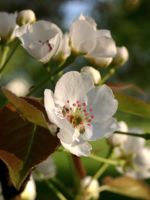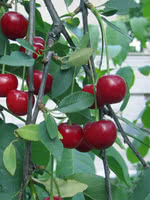Mon-Fri 9am - 5pm Mountain time
Ussurian Pear (Siberian) vs Sour Cherry
Pyrus ussuriensis
Prunus cerasus
NOT AVAILABLE THIS SEASON - MIGHT RETURN
Ussurian Pear is the most cold hardy of all pear species. It is frequently used as a rootstock or as a pollinizer for other pear varieties. The pinkish-white flowers that bloom in the spring and the striking fall colours make it well-suited as an ornamental addition to your landscape.
Ussurian Pear can also be used for forming hedges as it tends to branch quite low.
While the Ussurian Pear is considered self-pollinating, planting with another pear variety will increase yields. Can be paired with Krazulya Pear or Beedle Pear.
Sour Cherry is cold-hardy and typically grows as a small tree. In late spring, it produces clusters of fragrant white blossoms that mature into bright red, tart fruit. Although the cherries can be eaten fresh, they are most commonly used in baking and preserves.
While not native to North America, Sour Cherry serves as a larval host plant for the Eastern Tiger Swallowtail (Papilio glaucus), a butterfly native to eastern North America.
Sour cherries are self-fertile; however, planting near additional cherry trees for cross-pollination can increase yields.
This Sour Cherry is produced from seed collected from an Evans Cherry and is not clonally reproduced.

